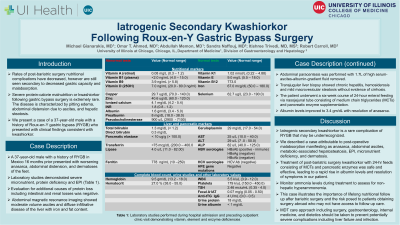Tuesday Poster Session
Category: Obesity
P4894 - Iatrogenic Secondary Kwashiorkor Following Roux-en-Y Gastric Bypass Surgery
Tuesday, October 29, 2024
10:30 AM - 4:00 PM ET
Location: Exhibit Hall E

Has Audio

Michael Gianarakis, MD
University of Illinois at Chicago
Chicago, IL
Presenting Author(s)
Michael Gianarakis, MD1, Omar T. Ahmed, MD1, Abdullah Memon, MD2, Sandra Naffouj, MD2, Itishree Trivedi, MD, MS3, Robert E.. Carroll, MD1
1University of Illinois at Chicago, Chicago, IL; 2University of Illinois College of Medicine, Chicago, IL; 3University of Illinois, Chicago, IL
Introduction: Rates of post-bariatric surgery nutritional complications have decreased, however are still seen secondary to decreased gastric capacity and malabsorption. Severe protein-calorie malnutrition or kwashiorkor following gastric bypass surgery is extremely rare. The disease is characterized by pitting edema, abdominal distension due to ascites, and hepatic steatosis. Herein, we present a case of a 37-year-old male with a history of Roux-en-Y gastric bypass (RYGB) who presented with clinical findings consistent with kwashiorkor.
Case Description/Methods: A 37-year-old male with a history of RYGB in Mexico 16 months prior presented with worsening anasarca, abdominal distension, and dermatoses of the feet. Laboratory studies demonstrated severe micronutrient, protein deficiency and EPI (Table 1). Evaluation for additional causes of protein loss including intestinal and renal losses was negative. Abdominal magnetic resonance imaging showed moderate volume ascites and diffuse infiltrative disease of the liver with iron and fat content. Abdominal paracentesis was performed with 1.7L of high serum-ascites-albumin-gradient fluid removed. Transjugular liver biopsy showed chronic hepatitis, hemosiderosis and mild macrovesicular steatosis without evidence of cirrhosis. The patient underwent a six-week course of 24-hour enteral feeding via nasojejunal tube consisting of medium chain triglycerides (MCTs) and pancreatic enzyme supplementation. Albumin levels improved to 3.4 gm/dL with resolution of anasarca.
Discussion: Iatrogenic secondary kwashiorkor is a rare complication of RYGB that may be underrecognized. We described a case attributable to post-operative malabsorption manifesting as anasarca, abdominal ascites, metabolic-associated hepatosteatosis, EPI, micronutrient deficiency, and dermatosis. Treatment of post-bariatric surgery kwashiorkor with 24-hr feeds consisting of MCTs and pancreatic enzymes was safe and effective, leading to a rapid rise in albumin levels and resolution of symptoms in our patient. It is important to monitor ammonia levels during treatment to assess for non-hepatic hyperammonemia. This case illustrates the importance of lifelong nutritional follow up after bariatric surgery and the risk posed to patients obtaining surgery abroad who may not have access to follow up care. A multidisciplinary care approach including surgery, gastroenterology, internal medicine, and dietetics should be taken to prevent potentially severe complications including liver failure and infection.
Note: The table for this abstract can be viewed in the ePoster Gallery section of the ACG 2024 ePoster Site or in The American Journal of Gastroenterology's abstract supplement issue, both of which will be available starting October 27, 2024.
Disclosures:
Michael Gianarakis, MD1, Omar T. Ahmed, MD1, Abdullah Memon, MD2, Sandra Naffouj, MD2, Itishree Trivedi, MD, MS3, Robert E.. Carroll, MD1. P4894 - Iatrogenic Secondary Kwashiorkor Following Roux-en-Y Gastric Bypass Surgery, ACG 2024 Annual Scientific Meeting Abstracts. Philadelphia, PA: American College of Gastroenterology.
1University of Illinois at Chicago, Chicago, IL; 2University of Illinois College of Medicine, Chicago, IL; 3University of Illinois, Chicago, IL
Introduction: Rates of post-bariatric surgery nutritional complications have decreased, however are still seen secondary to decreased gastric capacity and malabsorption. Severe protein-calorie malnutrition or kwashiorkor following gastric bypass surgery is extremely rare. The disease is characterized by pitting edema, abdominal distension due to ascites, and hepatic steatosis. Herein, we present a case of a 37-year-old male with a history of Roux-en-Y gastric bypass (RYGB) who presented with clinical findings consistent with kwashiorkor.
Case Description/Methods: A 37-year-old male with a history of RYGB in Mexico 16 months prior presented with worsening anasarca, abdominal distension, and dermatoses of the feet. Laboratory studies demonstrated severe micronutrient, protein deficiency and EPI (Table 1). Evaluation for additional causes of protein loss including intestinal and renal losses was negative. Abdominal magnetic resonance imaging showed moderate volume ascites and diffuse infiltrative disease of the liver with iron and fat content. Abdominal paracentesis was performed with 1.7L of high serum-ascites-albumin-gradient fluid removed. Transjugular liver biopsy showed chronic hepatitis, hemosiderosis and mild macrovesicular steatosis without evidence of cirrhosis. The patient underwent a six-week course of 24-hour enteral feeding via nasojejunal tube consisting of medium chain triglycerides (MCTs) and pancreatic enzyme supplementation. Albumin levels improved to 3.4 gm/dL with resolution of anasarca.
Discussion: Iatrogenic secondary kwashiorkor is a rare complication of RYGB that may be underrecognized. We described a case attributable to post-operative malabsorption manifesting as anasarca, abdominal ascites, metabolic-associated hepatosteatosis, EPI, micronutrient deficiency, and dermatosis. Treatment of post-bariatric surgery kwashiorkor with 24-hr feeds consisting of MCTs and pancreatic enzymes was safe and effective, leading to a rapid rise in albumin levels and resolution of symptoms in our patient. It is important to monitor ammonia levels during treatment to assess for non-hepatic hyperammonemia. This case illustrates the importance of lifelong nutritional follow up after bariatric surgery and the risk posed to patients obtaining surgery abroad who may not have access to follow up care. A multidisciplinary care approach including surgery, gastroenterology, internal medicine, and dietetics should be taken to prevent potentially severe complications including liver failure and infection.
Note: The table for this abstract can be viewed in the ePoster Gallery section of the ACG 2024 ePoster Site or in The American Journal of Gastroenterology's abstract supplement issue, both of which will be available starting October 27, 2024.
Disclosures:
Michael Gianarakis indicated no relevant financial relationships.
Omar Ahmed indicated no relevant financial relationships.
Abdullah Memon indicated no relevant financial relationships.
Sandra Naffouj indicated no relevant financial relationships.
Itishree Trivedi indicated no relevant financial relationships.
Robert Carroll indicated no relevant financial relationships.
Michael Gianarakis, MD1, Omar T. Ahmed, MD1, Abdullah Memon, MD2, Sandra Naffouj, MD2, Itishree Trivedi, MD, MS3, Robert E.. Carroll, MD1. P4894 - Iatrogenic Secondary Kwashiorkor Following Roux-en-Y Gastric Bypass Surgery, ACG 2024 Annual Scientific Meeting Abstracts. Philadelphia, PA: American College of Gastroenterology.

